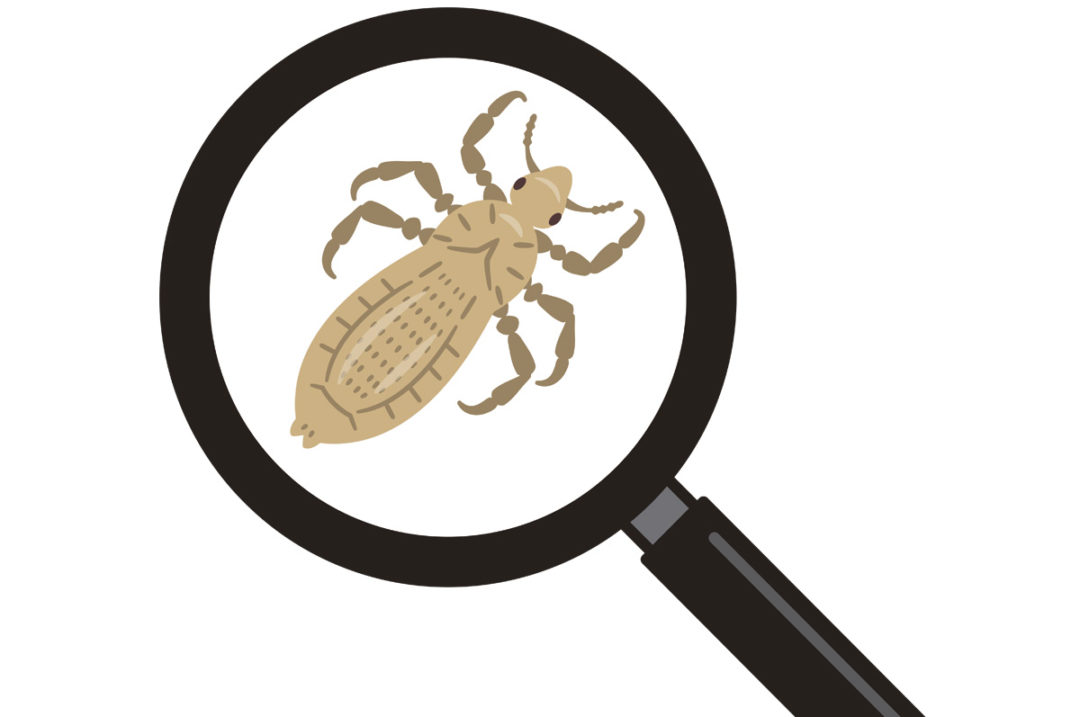What are cows doing if parasites are hanging around? Certainly not what they’re supposed to be doing.
External parasites can affect a cow’s milk production immediately because cows will spend their time scratching instead of eating or resting. We often see a jump in milk production within days of treating a herd, even in herds that did not show signs of an obvious mange or lice problem.
Know the enemy
Understanding what types of parasites are in your dairy herd is the first step toward successful management. Lice and mange are the most common external parasites of concern for dairy producers. There are two types of lice to look out for: biting lice and sucking lice. Biting lice cause irritation by scraping or abrading the skin or hair, while sucking lice extract blood from their host. Like lice, there are two types of mange to be aware of: chorioptic mange (most common) and sarcoptic mange (much less common). Lice on cattle are commonly found on the neck, shoulders and back, while mange mites usually live around the tailhead region.
While all external parasites cause itching and discomfort in cattle, it is important to know the defining clinical signs of mange versus lice. Mange, for example, will cause hair loss, crusting/wrinkled skin around the tailhead and areas above the rear udder or medial thigh, and – in more serious cases – skin lesions on the neck, shoulder, brisket, rump or inner thighs. On the other hand, lice will present themselves by causing scratching, hair loss (typically from rubbing on posts) and raw patches.
Establish an effective control program
To avoid outbreaks, treat your cattle before prime seasons in which parasites spread. Generally, external parasites become more active in the late fall and winter months, so I recommend that producers pour their entire herd between the end of November and end of December. Mange and lice thrive in cooler temperatures, as longer hair coats allow for prolonged survival.
We also need to be pouring all new herd additions that could be harboring parasites from a previous location 14 days before they join the herd.
Following label directions can significantly impact the effectiveness of the dewormer. When using a pour-on dewormer, carefully apply the product along the topline in a narrow strip from withers to tailhead. This will reduce product runoff and maximize efficacy.
Administering the correct dose is another important practice. Although convenient, dosing to the average weight of the herd will under- or overdose many cows. Underdosing will diminish effectiveness of the dewormer and contribute to parasite resistance, while overdosing wastes product and money. Using a scale, weight tape or a cull-weight slip to determine cow weight will increase dosing accuracy along with product efficacy.
Once external parasite treatments have been administered, producers will likely notice a bump in production rates. In fact, a single application of a quality pour-on dewormer can increase milk production by over 3 pounds per cow, per day.
Choose a quality product
When looking at topical pour-on dewormers, choose products with long periods of activity after application. While generic dewormers are often less costly, look closely at the label and the data used to back up the product’s performance claims.
Most species of lice and mites can only infect cattle. However, sarcoptic mange can jump species to humans. As such, find a product that is labeled to treat sarcoptic mange as well as other common species to protect the health of not only the herd but also the health of farm employees.
Most importantly, all deworming products used on a dairy farm should be labeled for use in lactating, adult cows and have a zero milk withhold.
It is important to note that ivermectin is not approved for use in lactating cows, including dry cows and heifers 20 months old or older. In fact, any amount detected in milk is considered illegal and can result in milk dumps as well as FDA violations and fines.
Consult your veterinarian
Parasite populations, product selection, timing of application and adherence to label directions are all factors that influence the potential return on investment for your pour-on dewormer. Your local veterinarian is your best cattle parasite resource and can help develop a deworming program to maximize cow comfort and performance on your operation.
References omitted but are available upon request by sending an email to the editor.







